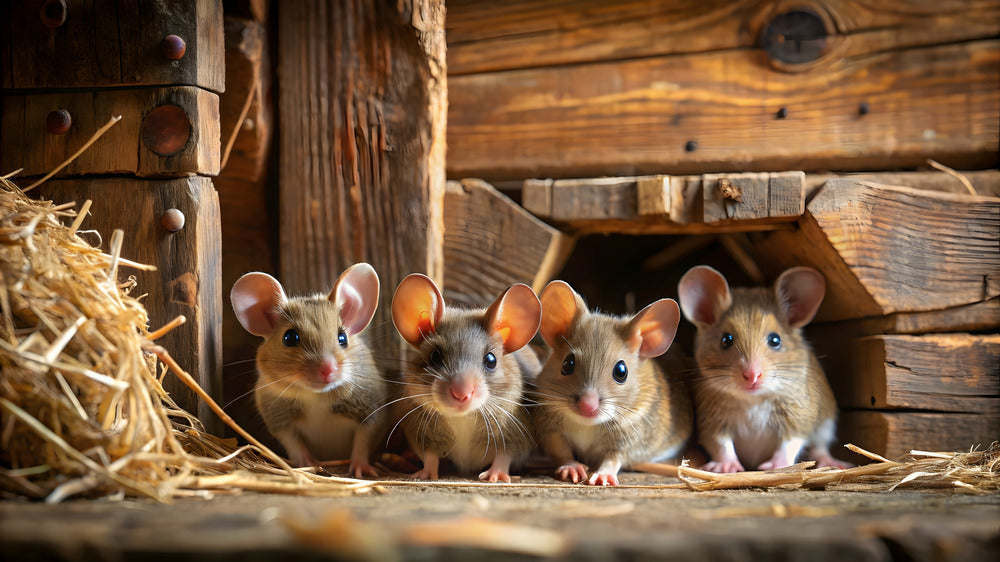
How Fast Do Mice Multiply? A Look at Infestation Timelines
Share
A single mouse might seem harmless — tucked away in a quiet corner of your attic, garage, or basement — but don’t be fooled. In just a few short months, a pair of mice can give rise to dozens, and eventually hundreds, putting your home, your vehicle, and even your health at risk.
And the damage they cause? It can get expensive, fast.
Whether you’re storing a car, RV, or camper — or simply noticing signs of activity in your home — understanding how quickly mice multiply is the first step toward preventing a full-blown infestation.
So … How Fast Do Mice Multiply?
Under ideal conditions, two mice can theoretically create a population of over 5,000 within just one year. That number might sound outrageous — but when you factor in their short gestation cycle, large litters, and rapid sexual maturity, it starts to make sense.
At a glance:
- Mice reach sexual maturity in 6 weeks
- A female can give birth every 3–4 weeks
- Litter sizes average 5–8 pups
- Each female can have up to 10 litters per year
- Mice can become pregnant within 24 hours of giving birth
The result? One female mouse can produce up to 80 pups in a year — and each of her daughters can begin doing the same just six weeks after birth.
Let’s break that down.
Theoretical Mouse Population Growth
Here’s a simplified look at how a mouse population can grow exponentially over the course of a year, assuming just one starting pair of mice and optimal conditions:
| Month | Estimated Mice | Notes |
|---|---|---|
| 1 | 2 | Initial breeding pair |
| 2 | 12–20 | First litter born |
| 3 | 40–60 | Second litter + daughters begin breeding |
| 6 | 500+ | Multiple generations active |
| 12 | 2,000–5,000+ | Full infestation |
A Closer Look at Mouse Reproduction
Mice living in safe, indoor environments can reproduce anywhere from 5 to 10 times per year. And when you consider that a female mouse reaches sexual maturity just six weeks after birth, those numbers can escalate quickly.
Gestation and Breeding Cycle
- Gestation Period: 19–21 days
- Time Between Litters: A female mouse can become pregnant again within 24 hours of giving birth.
- Litters Per Year: Up to 10 per female
Litter Size and Offspring
- Average Litter Size: 5–8 pups
- Max Reported: Up to 14 pups
- Survival Rate Indoors: High — few predators, stable temperatures, and reliable food sources
Reproductive Timeline
- Average Lifespan: 1 to 2 years
- Reproductive Window: From 6 weeks old until death
In other words, if you see a mouse, chances are you’ve already got several more hiding — and more on the way.
Why Indoor Spaces Accelerate the Problem
Mice thrive in places where:
- They aren’t frequently disturbed
- There’s a steady food source (pet food, crumbs, seeds, etc.)
- Nesting materials are available (insulation, cardboard, upholstery)
- They’re protected from cold, predators, and the elements
Your garage, basement, RV, or classic car in storage checks every one of those boxes.
That’s why infestations tend to spread so quickly indoors — and why people are often unaware until it’s already a big problem.
Signs of a Mouse Infestation
Not sure if you’re dealing with more than just a stray mouse? Look for these telltale signs:
- Droppings: Small, dark pellets in corners, drawers, or near food
- Chewed Materials: Wires, cardboard, insulation, car interiors
- Musty Smells: A strong ammonia-like odor from urine
- Noises: Scratching, scurrying, or squeaking at night
- Nests: Shredded paper, fabric, or insulation in hidden spaces
Even one of these signs is worth taking seriously. By the time you’re seeing droppings or hearing movement, there may already be multiple generations nesting nearby. For more information, check out our full guide.

How to Stop a Mouse Infestation Before It Starts
Once mice start breeding, things get out of control fast. That’s why the best strategy is prevention — and Box-Kat is one of the most effective ways to do it.
Why Use a Box-Kat Mouse Barrier?
Box-Kat creates a physical perimeter around your stored vehicle using interlocking panels mice can’t climb, chew, or squeeze past.
- No traps or poisons — safe for pets and children
- Long-lasting materials — designed for all seasons
- Simple to set up — takes just minutes to install
- Trusted by thousands — from RV owners to classic car collectors
If you’re storing a vehicle for any length of time — even just a few weeks — it’s worth taking steps to keep rodents out. Once they’re in, the clock is ticking.
FAQs About Mouse Infestations
Q: Can one mouse really turn into a whole infestation?
A: Yes. If it’s a pregnant female, you could have a litter in under three weeks — and her offspring will start breeding in just over a month.
Q: Do mice breed faster indoors?
A: Typically, yes. Indoor environments offer more consistent warmth, food, and safety — all of which speed up reproduction.
Q: How long until I notice signs of an infestation?
A: It can take weeks before visible signs show up. Mice are excellent at staying hidden — so by the time you see droppings or hear noises, the problem may already be several generations deep.
Q: What’s the most effective way to prevent mice from getting in?
A: Sealing entry points and removing food sources are crucial — but for stored vehicles, a physical barrier like Box-Kat offers unmatched protection.
Don’t Let Mice Get a Head Start
Mice don’t need much time — or many resources — to turn a minor problem into a costly infestation. By understanding just how fast they multiply, you’ll be better prepared to act early and protect your property.
Whether you’re storing your camper for the winter or parking your classic car for a month, now is the time to prevent mice from making themselves at home.
Check out Box-Kat’s full line of mouse barriers and protect your space before things multiply.



